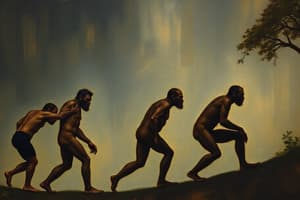Podcast
Questions and Answers
What was the primary purpose of the Hammurabi Code?
What was the primary purpose of the Hammurabi Code?
- To define laws governing society (correct)
- To promote military strategies
- To establish trade agreements
- To celebrate agricultural achievements
Which social class in Babylonian society included kings and priests?
Which social class in Babylonian society included kings and priests?
- Slaves
- Freemen
- Nobles (correct)
- Commoners
What significant contribution did the Assyrians make to warfare?
What significant contribution did the Assyrians make to warfare?
- Use of iron weapons and chariots (correct)
- Introduction of chemical warfare
- Invention of armor
- Development of naval strategies
Who was responsible for the construction of the Hanging Gardens of Babylon?
Who was responsible for the construction of the Hanging Gardens of Babylon?
Which civilization was the first to utilize iron in their weaponry?
Which civilization was the first to utilize iron in their weaponry?
What caused the decline of the Assyrian Empire during the reign of Ashurbanipal?
What caused the decline of the Assyrian Empire during the reign of Ashurbanipal?
Which group was considered as 'freemen' in Babylonian society?
Which group was considered as 'freemen' in Babylonian society?
What was the Chaldean Empire also known as?
What was the Chaldean Empire also known as?
What was one of the greatest contributions of the Phoenicians?
What was one of the greatest contributions of the Phoenicians?
What was significant about the Phoenician alphabet?
What was significant about the Phoenician alphabet?
What role did Moses play in Jewish history according to the content?
What role did Moses play in Jewish history according to the content?
What dynasty did Cyrus the Great found?
What dynasty did Cyrus the Great found?
What was the role of 'satraps' in the Persian Empire?
What was the role of 'satraps' in the Persian Empire?
What economic innovation did Darius I introduce?
What economic innovation did Darius I introduce?
Which event significantly impacted the Jewish population in Palestine?
Which event significantly impacted the Jewish population in Palestine?
What led to the decline of Persia's glory and power?
What led to the decline of Persia's glory and power?
Which species is known for being the first to use stone tools?
Which species is known for being the first to use stone tools?
What significant characteristic distinguished Homo Erectus from earlier hominids?
What significant characteristic distinguished Homo Erectus from earlier hominids?
Which hominid is often referred to as 'the missing link'?
Which hominid is often referred to as 'the missing link'?
What is the age of the skeleton known as 'Lucy', a significant find in the study of human evolution?
What is the age of the skeleton known as 'Lucy', a significant find in the study of human evolution?
Which hominid is characterized by having a brain size comparable to a modern ape's?
Which hominid is characterized by having a brain size comparable to a modern ape's?
What notable feature is attributed to Zinjanthropus, also known as 'East African Man'?
What notable feature is attributed to Zinjanthropus, also known as 'East African Man'?
Which of the following is NOT a characteristic of Homo Erectus?
Which of the following is NOT a characteristic of Homo Erectus?
Where were significant fossils of the hominid Ramapithecus found?
Where were significant fossils of the hominid Ramapithecus found?
What physical features characterize Homo Sapien?
What physical features characterize Homo Sapien?
Which invention is attributed to the Sumerians?
Which invention is attributed to the Sumerians?
What was significant about Hammurabi in relation to the Babylonian Empire?
What was significant about Hammurabi in relation to the Babylonian Empire?
What does the term 'Mesopotamia' mean?
What does the term 'Mesopotamia' mean?
Which of the following was NOT a feature of the Sumerian civilization?
Which of the following was NOT a feature of the Sumerian civilization?
Who was the first ruler to create an empire by conquering Sumerian city-states?
Who was the first ruler to create an empire by conquering Sumerian city-states?
What type of tools did Cro-Magnon Man primarily utilize?
What type of tools did Cro-Magnon Man primarily utilize?
Which of the following characteristics was NOT attributed to Neanderthal Man?
Which of the following characteristics was NOT attributed to Neanderthal Man?
Flashcards are hidden until you start studying
Study Notes
The stages of Human evolution
- Hominid: A more advanced primate that developed manlike characteristics around a million years ago. Ramapithecus is believed to be an early example. Remains have been found in the Siwalik Hills of India and Africa.
- Homo Habilis: Also known as "Handy Man," this stage of human evolution emerged about 2 million years ago, marked by the invention of stone tools. "Zinjanthropus" or "East African Man" is an example, dated to around 1.75 million years old.
- Homo Erectus: Known as "Upright Man," this stage signifies the first truly manlike creature. Homo erectus walked upright, used fire, crafted stone weapons and hunted large animals. Java Man (Pithecanthropus Erectus) and Peking Man (Sinanthropus Pekinesis) were prominent examples.
- Homo Sapien: This stage represents the evolution of modern humans. Homo sapiens are muscular, upright, with a large, protruding face and low forehead. They lived in small family groups, as hunters and cave/tent dwellers. Notable types include Neanderthal Man, known for intelligence and early religious concepts, and Cro-Magnon Man, who wore animal skins, made fire, were skilled hunters and artists.
Cradle of Mankind
- The remains of hominids were found in the Siwalik Hills of India and Africa.
- "Lucy," was discovered by American archaeologist Donald C. Johansonn in 1974 in Ethiopia. Her skeleton indicates she was a 3-1/2 feet tall teenage girl, 3.5 million years old, with a softball-sized head.
- Australopithecus, another hominid species, inhabited Eastern and Southern Africa. They had ape-sized brains but walked straight and used simple tools.
Sumerians - The First Builders of Civilization
- The Sumerians were the world's first civilization, located in Mesopotamia, now Iraq, between the Tigris and Euphrates rivers.
- They developed advanced irrigation systems including canals and dikes to control flooding and cultivate the fertile land.
- The Sumerians invented the plow, wheel, and cuneiform writing, using wedge-shaped characters.
- They were the world's first known law-makers, with Ur-nammu, a Sumerian king, enacting the first law codes.
- The Sumerians were the first to combine copper and tin, creating bronze, which they used for weapons, ornaments, tools, and warfare.
- They created the oldest known city map in the world (Nippur).
The Akkadian Empire - The First Empire
- King Sargon of Akkad conquered the Sumerian city-states, establishing the first empire.
- The Akkadian Empire extended from the Persian Gulf to the Mediterranean Sea, lasting for approximately two centuries.
The Babylonian Empire
- Semitic people from Syria invaded Mesopotamia to establish the Babylonian Empire.
- King Hammurabi, a powerful conqueror, led Babylonia to its height of splendor.
- Hammurabi fostered trade and commerce and is known for the Hammurabi Code, a comprehensive law system inscribed on an eight-foot-tall black stone. The code encompassed family relationships, property rights, marriage, adoption, labor, commerce, and crimes.
- The concept of “an eye for an eye” and “a life for a life” originated from the Hammurabi Code.
- Babylonian society had a hierarchical structure with nobles, freemen, and slaves.
The Assyrian Empire
- The Assyrians revolutionized warfare, using iron weapons and chariots to become skilled warriors.
- Tiglath Pileser I founded the Assyrian Empire.
- The Assyrians dominated ancient Asia but declined under Ashurbanipal, who favored peace over war.
The Chaldean Empire
- The Chaldean Empire, also known as the Second Babylonian Empire, emerged from the decline of the Assyrian Empire.
- The crowning achievement of Babylon was the Hanging Gardens of Babylon, one of the Seven Wonders of the Ancient World.
- Nebuchadnezzar, the Chaldean king, constructed these gardens to please his wife.
- The Chaldean Empire reached its zenith under Nebuchadnezzar.
The Hittites - The First Nation to Use Iron
- The Hittites, an Indo-European civilization, settled in Asia Minor.
- They were a war-like people who famously defeated Pharaoh Rameses II in the Battle of Kadesh.
- The Hittites were the first to use iron in tools and weapons. -They also wielded horse-drawn chariots in warfare.
The Phoenicians - The Greatest Sailors
- The Phoenicians were known for their purple dye, extracted from a particular type of shellfish, and how the name "Phoenicia" comes from "phoenix" which is the name of the dye.
- They were a seafaring civilization forced to seek livelihood on the sea due to the poor soil of their land in present-day Lebanon.
- They used cedarwood from Lebanon to build seagoing ships.
- The Phoenicians contributed to the world by inventing the alphabet, the first to use alphabetical writing. Their alphabet had 24 consonant letters, with "aleph" (ox), and "beth" (house) being the first two letters.
The Jews - Hebrews
- Jews, also known as Hebrews, were pastoral Semitic people originally from the Arabian Desert.
- They migrated to Mesopotamia.
- They were taken into captivity and slavery in Egypt by Pharaoh Rameses II, but Moses led them out of Egypt and into the wilderness of the Sinai Peninsula.
- While considered the "chosen people of God," they worshipped various gods.
- They faced conquest and exile over time, including the destruction of Jerusalem by the Roman Empire.
- Emperor Titus of the Roman Empire massacred Jews to drive the rest into exile.
- The Jews' contribution to civilization led to the development of modern banking and lending for business.
The Persians
- Cyrus the Great conquered Mesopotamia and Egypt.
- He founded the Achaemenid dynasty, marking the beginning of the Persian Empire.
- The empire reached its Golden Age under Darius I, known as the "King of Kings."
- Darius I divided the empire into 20 provinces called satrapies, each under a governor called a satrap.
- Darius I introduced coinage, including the daric gold coin, named after him.
- After Darius I's death, Persia declined due to weak rulers.
Studying That Suits You
Use AI to generate personalized quizzes and flashcards to suit your learning preferences.




